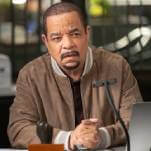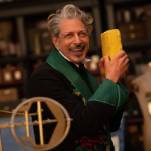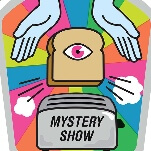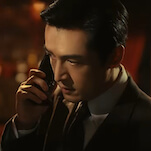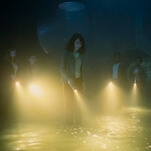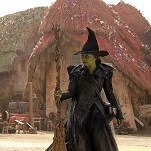The announcement that CBS would air a modern adaptation of Sir Arthur Conan Doyle’s most famous character was met with a certain amount of skepticism. This was understandable. The world was not exactly hurting for new versions of Sherlock Holmes, and any attempt to tell more stories about the influential icon smacked less of creative inspiration than of a desire to attract audiences with something almost, but not exactly, the same as something they already liked. Even more damningly, there was already a modern adaptation of Sherlock Holmes on the air: BBC One’s Sherlock, starring Benedict Cumberbatch as the World’s Greatest Detective, alongside Martin Freeman as His Guy Watson. Debuting in 2010, two years before Elementary’s premiere, the series created by Steven Moffat and Mark Gatiss arguably filled any conceivable Holmes-shaped hole in viewers’ lives. Surely another take on the iconic character from creator Robert Doherty would be a disappointing, pale copy by comparison. He’d even turned Watson into a woman. The absolute nerve.
Hopefully the skeptics gave Elementary enough benefit of the doubt to watch a few episodes. Turning John into Joan (and casting Lucy Liu in the role) wasn’t just a gimmick, but rather the central part of a commitment to finding a new take on the Holmesian mythology. Over the course of its first season and a half, the series has defined itself as a thoughtful, sharp, warm investigation into the central characters’ history, relationships, and philosophy. There’s a wholly unexpected, and entirely welcome, vitality to Elementary at its best, a sense of new ground being uncovered rather than old ground being re-trod—and while it’s not perfect, it does more than simply justify its existence. By now, the antisocial genius who solves crimes without being able to understand people is a trope so old it reads like a Mad Lib waiting for the latest iteration of proper noun/verb/adjective. But Doherty and his writers have found new life in the concept by creating an antisocial genius who is more than a cartoon. In doing so, they’ve given us a new, but still recognizable, Sherlock Holmes (Jonny Lee Miller), one who is in many ways superior to his Cumberbatchian counterpart.
The major objection to Elementary before it debuted was its apparent superfluity, but that objection no longer holds water; there’s something gratifying in knowing that for once, the cynical (and sensible) reaction to the news that two different networks were developing the same source material was proven false. While Sherlock’s playful style and Tumblr-friendly leads have their pleasures, the show also has some significant flaws, flaws that Elementary, in its low-key, airs-on-CBS-so-we-all-assume-it’s-for-old-people way, has largely avoided. Shocking as it may be, considering their relative positions in the pop culture zeitgeist, Elementary is a fundamentally better series, with a richer supporting cast, a more consistently rewarding structure, and a far more compelling perspective on its protagonist.
Sherlock’s episodic design is both one of its great strengths and its biggest weaknesses. British television seasons (or series; we’ll stick to “seasons” here to avoid a bad comedy routine) are typically shorter than American ones, but Sherlock takes this to the extreme, with only three episodes per season, each running roughly 90 minutes. On the plus side, this allows for greater dramatic builds, as movie-length stories are allowed to play out without needing to break into smaller, 45-minute chunks. But the limited episode number makes for a severe shortage of distinct mysteries. By and large, each Sherlock entry keeps its focus on a single plotline, and while the best episodes have enough twists and turns to keep that line from dragging, there’s little of the comforting regularity that Doyle’s fiction generally delivered. The few Holmes novels aside, the detective’s main presence was in short fiction, and its familiar routines work best in the aggregate. By limiting the characters’ exposure, the BBC series puts substantially more focus on big moments and iconic surprises, often to its detriment. And in those cases when a mystery fails to live up to snuff (like, say, “The Blind Banker,” with its dimly racist Orientalism, or “The Hounds Of Baskerville,” which comes perilously close to Scooby-Doo territory), it means a third of a season’s worth of plotting wasted.
Operating under the traditional American television model, Elementary is allowed more room to breathe. With only a season and a half under its belt, the show has put out nearly 40 episodes; and while not every one of those episodes is a classic, it matters significantly less when a particular adventure fails to live up to expectations. Each episode of Sherlock must be, by the show’s design, an event. This leads to episodes that are wildly dramatic but often lacking in substance, relying on flashy twists and excessive (if frequently effective) emotional manipulation to reach audiences. In contrast, Elementary, with its stolid procedural approach and more conventional pacing, gains strength from allowing character responses in situations to develop naturally over time. Season-long mysteries can fade into the background when necessary, offering the chance for steadier pacing, and far more consistent world building.
This leads to another area in which Elementary is superior to Sherlock: the depth and variety of its supporting cast. Six episodes in, Sherlock has its two leads, and they are unquestionably the strongest figures in the series. That isn’t in itself a complaint; Sherlock and Watson are necessarily the focus of their own stories, and if Cumberbatch and Freeman didn’t work so well together, there wouldn’t be a show. The problem is that the two men don’t exist in a vacuum, and while there is a supporting ensemble surrounding them, that ensemble exists largely to offer straight lines for Sherlock to bounce off of. Mrs. Hudson (Una Stubbs), Molly Hooper (Louise Brealey), and DI Lestrade (Rupert Graves) are likable figures, but they have little selves beyond their relationships with the leads. Even Mycroft, Sherlock’s brother (played by show co-creator Mark Gatiss), who operates in the highest echelons of British government, is largely a distant observer who steps in when a plot needs instigating or resolving. It’s not necessary for every character to have a rich inner life, but apart from the actors’ game efforts, it’s often hard to detect if these people have any lives at all. This limits the writers’ options; outside of guest stars, the only character pairing to generate reliable dramatic energy is Sherlock and John, and the need to find ways to keep them vital together is already showing signs of strain at the start of the show’s third season.
Elementary fares much better. People like Captain Thomas Gregson (Aidan Quinn) and Detective Marcus Bell (Jon Michael Hill) didn’t arrive on the scene fully fleshed out, but over the course of the show’s run, they’ve developed into more than just exposition delivery devices. Gregson’s home life was the subject of at least one storyline, and his occasional issues with Holmes’ methods make him more than just a good-natured doof relying on an outsider to do his job for him; this season, Bell was injured in the line of duty as a direct result of Holmes’ carelessness, and his recovery has become a small but important running storyline. Elementary’s Mycroft (Rhys Ifan) has a complicated relationship with Sherlock that suggests resentments and affection lingering beneath the surface, and Alfredo Llamaso (Ato Essandoh), Sherlock’s AA sponsor, helps keep the detective’s addiction problems a relevant part of the series.
Even Elementary’s take on Watson is more complex and interesting. The Sherlock version is perfectly acceptable: Freeman is well cast, and does a fine job of switching between outrage, awkward double takes, and astonishment. But it was established in the first episode that Watson’s war experience (he served as an army doctor in Afghanistan) had deeply affected him, and this has been largely forgotten, outside of the occasional tossed-off bit of dialogue. Though he’s given the dignity of outside work and occasional love interests, Watson’s main job is to react to Sherlock. As Joan Watson, on the other hand, Lucy Liu gives life to one of the stronger female roles on network television, a former surgeon turned sober companion who first meets Sherlock when his father hires her to help him go (and stay) drug-free. Over the course of the first season, Watson helped bring balance and perspective into Holmes’s world, while he, in turn, offered her a glimpse of the challenges and gratification of investigative work. It’s an equal partnership that allows Watson agency and standing without diminishing Holmes’ gifts.
The best development of Elementary’s first season is also one that requires a bit of spoiling; if you haven’t seen the season, and have avoided learning about it, feel free to skip this paragraph. For both TV versions of Holmes, it was inevitable that Moriarty would eventually come into play. Despite appearing only briefly in Doyle’s stories (and basically having been created so the author could have an excuse to kill off his most famous creation), the evil professor has long been a key figure in Holmesian lore. On Sherlock, Moriarty (Andrew Scott) was a bratty, petulant psychopath, a twisted mirror version of Sherlock’s own childish self-regard. All well and good, but there’s nothing particularly innovative about this take, and the showdown between hero and villain, for all the fireworks surrounding it, was never much in doubt. Elementary, however, decided to combine Moriarity with another of piece of the mythology: Irene “The Woman” Adler. On Sherlock, Adler is a dominatrix who briefly defeats Holmes before her emotions get the better of her (a twist that manages the neat trick of being even less progressive than the Victorian-era short story which inspired it). But the Adler to Miller’s Holmes is a former lover whom he initially believes to have been murdered; her death sent him to drug addiction, which in turn led to his arrangement in New York with Joan Watson. The twist being that Adler isn’t dead, and is, in fact, the mysterious “Moriarty” whom Sherlock spends most of the first season tracking down. The idea of Sherlock being infatuated with his criminal counterpart (and apparent intellectual match), feelings which don’t disappear even when he helps turn her over to the police, offers tremendous opportunities going forward, and, in retrospect, seems like the most natural idea in the world. Who else would a man obsessed with solving crime fall in love with?
The key difference between Sherlock and Elementary comes down to the way each show treats its protagonist. Everything in Sherlock revolves around Sherlock. He is the series’ sole reason for existing, and the dynamic remains frozen in amber. Sherlock will do something outrageous, everyone will gasp, but then he’ll solve a crime or offer a token gesture of commiseration, and everyone will move on. It gets old, because the show simultaneously wants its audience to be shocked by Sherlock’s behavior, and charmed by his roguish self-regard and evident brilliance, without much variation. Elementary takes a broader view. As Sherlock, Miller is often standoffish and arrogant, but he exists in a world that refuses to let him off the hook for his mistakes or his behavior; better still, he recognizes his failings, and is clearly working toward addressing them. This doesn’t mean the series is about “fixing” Holmes, or even that the character is inherently broken, but it allows for the possibility of growth and change. On Sherlock, Holmes is constantly bemoaning that he’s surrounded by idiots, and it’s hard to argue his point. On Elementary, Holmes is engaged in the slow, painful process of accepting that those “idiots” might have something to teach him. The former has its moments, but the latter makes for better television and more rewarding art.


